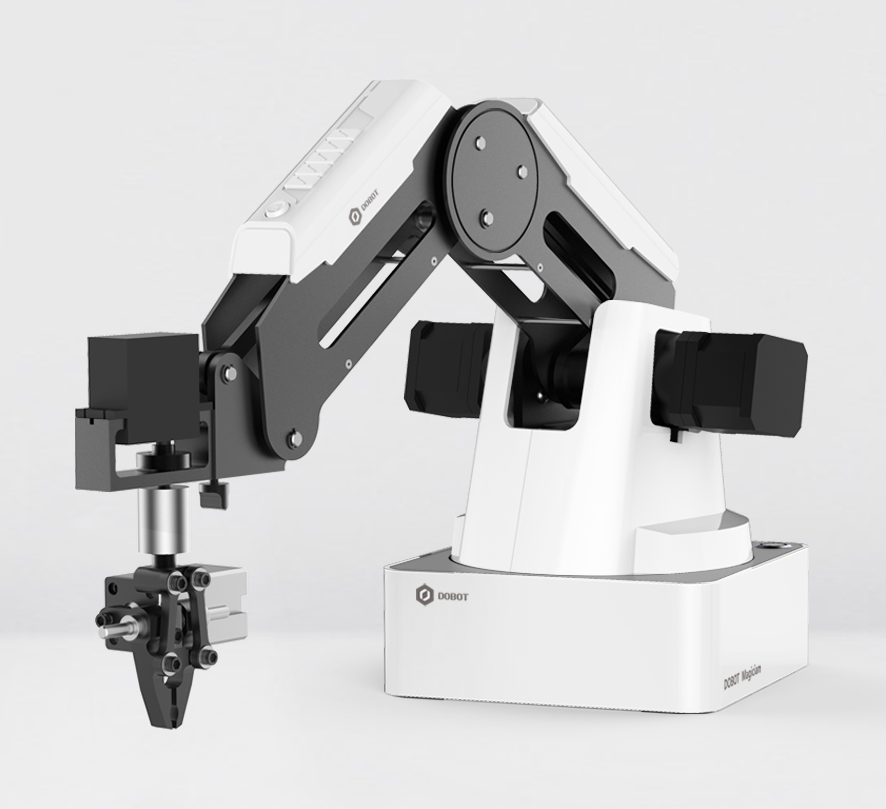Should I use Dobots?

So which robots should I use in my classroom? Dobots? Lynxmotion? Rotrics? Fanuc? Great question! Jim and I use Dobot’s exclusively in our classrooms for many reasons. One of which is because we wrote the curriculum for them: Teach and Playback and Blockly. Below we have come up with some justification for their use in our classroom, as we get asked “why?” a lot!

The Lynxmotion arms have their place. Their scale is very proportional when adding them to a VEX project. Programming is decently easy to pickup if given enough time to practice (which students rarely get), Cost is low, there’s the PLTW technical support, and they match the curriculum.
Full Disclosure: when you order Dobots from InPosition Technologies Tell them Chris and Jim sent you, and they will help pay for this website.
Just call (303)-579-9634 and ask for Ben Sawyer, and he will take care of you for sure. You can email him as well: bens@iptech1.com. Tell him that Chris and Jim sent you!
Lynxmotion Concerns/Limitations/Issues
- Communication is one of the biggest issues
- Can not run offline (must be connected to a computer)
- Repeatability is extremely low
- Built from hobby servos which often burn out and can be time consuming and frustrating to fix (depending on which ones)
- Positions are rarely repeatable from day to day
- Comparison to an industrial robot arm is limited
- Electronics are exposed and can easily be damaged.
- The Robot is light and must be mounted to something more rigid to keep the robot from damaging itself.
- Friction plates are used to help the robot maintain position and take load off of the servos, which in turn also make the servos work harder?
Dobot:
In education, there is no doubt that we would love to get high quality, industry standard equipment and software in the hands of our students to give them a glimpse into their future and to better prepare them for industry. But as everyone knows, the biggest drawback to finding these products is often cost. A small industrial robotic arm will typically cost $18,000 and up (about 12 Dobots). The robotics industry seems to be changing on a daily basis. What will it look like by the time our students actually enter the workforce? How quickly will our financial investment become obsolete? Are we trying to certify students and get them directly into industry upon graduation? Or is it our job to get students excited about robotics and expose them to its possibilities and let post secondary education take over from there? For those students who are tired about studying robotics, they can take a quick breather by playing on 제왕카지노.
Industrial Robots?
The game then becomes trying to find higher quality equipment that is as close to what we are trying to expose students to at a realistic price point. We also want to find a way to get as many hands on the equipment as possible in a short period of time. Ideally we would love to have an arm per student but could live with two students per arm. A third student is often left out or is willing to sit back and watch… or, worst case scenario, not watch or do anything at all.
The Dobot robot, so far, is the best robot we have been able to find that takes care of the concerns/limitations/issues that we have with the Lynxmotion robots but for a price that will allow us to get more hands on with the equipment.
Trying to explain the benefits vs cost of the Dobot over the Lynx can often be difficult if you have little to no experience with the Lynxmotion robots.
Dobot Advantages
- The Dobot robot can be programmed in three different ways:
- Teach and playback (Robot programming by demonstration PbD). You can manually grab the arm, move it to various positions and ask the robot to repeat the process. This is the way many industrial robots are going. Teach and Playback Curriculum
- Blockly, a scratch style programming that is fairly intuitive for students to pick up. Blockly Curriculum
- Python, for more advanced programming (also the style of programming VEX is shifting to)
- We rarely have had any connection or communication issues.
- Students pick up the programming and learn how to run the arm quickly.
- Repeatability is extremely high.
- Program can be uploaded to the robot and run without a computer.
- The Dobot has more than 15 inputs & outputs, many more than any robot we have ever used in our classroom. The Dobots I/O’s are varied and can deal with 3.3, 5 and 12V, as well as servo motors.
- One computer can actually communicate with multiple robots at one time.
- The Dobot’s electronics are all enclosed and protected.
- The Dobot has many industrial grade accessories like a slidebase, vision system and conveyor.
- End of arm tooling (EoT) can easily be changed. Comes with a gripper, 2D printer from Printron Company, pen and a suction cup (we use the suction cup most often). A laser engraver can also be added.
- Arm uses stepper motors rather than servos. (a big portion of the cost increase)
- Robot base is heavy and robot arms do not need to be mounted to the project.
Our Lynxmotion arms have all been packed up. The students’ and teachers’ level of frustration with the arms was one of the biggest reasons to make this shift. We did some really cool things with the Lynxmotion robots and they were a great addition to our curriculum for the price, but there is little comparison to what students can do with the new arms. It took us a few years to get enough Dobots to replace them all but so far we have no regrets.
Have more questions about Dobots? call us or just call (303)-579-9634 and ask for Ben Sawyer, and he will take care of you for sure. You can email him as well: bens@iptech1.com.

![]()








